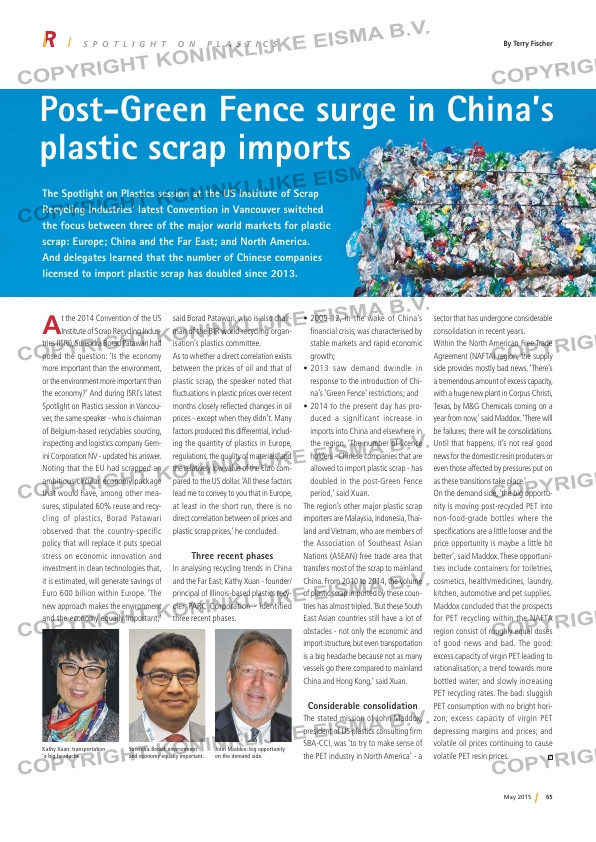Page 65 from: May 2015

65May 2015
Post-Green Fence surge in China’s
plastic scrap imports
The Spotlight on Plastics session at the US Institute of Scrap
Recycling Industries’ latest Convention in Vancouver switched
the focus between three of the major world markets for plastic
scrap: Europe; China and the Far East; and North America.
And delegates learned that the number of Chinese companies
licensed to import plastic scrap has doubled since 2013.
At the 2014 Convention of the US Institute of Scrap Recycling Indus-
tries (ISRI), Surendra Borad Patawari had
posed the question: ‘Is the economy
more important than the environment,
or the environment more important than
the economy?’ And during ISRI’s latest
Spotlight on Plastics session in Vancou-
ver, the same speaker – who is chairman
of Belgium-based recyclables sourcing,
inspecting and logistics company Gem-
ini Corporation NV – updated his answer.
Noting that the EU had scrapped an
ambitious circular economy package
that would have, among other mea-
sures, stipulated 60% reuse and recy-
cling of plastics, Borad Patawari
observed that the country-specific
policy that will replace it puts special
stress on economic innovation and
investment in clean technologies that,
it is estimated, will generate savings of
Euro 600 billion within Europe. ‘The
new approach makes the environment
and the economy equally important,’
said Borad Patawari, who is also chair-
man of the BIR world recycling organ-
isation’s plastics committee.
As to whether a direct correlation exists
between the prices of oil and that of
plastic scrap, the speaker noted that
fluctuations in plastic prices over recent
months closely reflected changes in oil
prices – except when they didn’t. Many
factors produced this differential, includ-
ing the quantity of plastics in Europe,
regulations, the quality of materials, and
the relatively low value of the Euro com-
pared to the US dollar. ‘All these factors
lead me to convey to you that in Europe,
at least in the short run, there is no
direct correlation between oil prices and
plastic scrap prices,’ he concluded.
Three recent phases
In analysing recycling trends in China
and the Far East, Kathy Xuan – founder/
principal of Illinois-based plastics recy-
cler PARC Corporation – identified
three recent phases.
• 2009-12, in the wake of China’s
financial crisis, was characterised by
stable markets and rapid economic
growth;
• 2013 saw demand dwindle in
response to the introduction of Chi-
na’s ‘Green Fence’ restrictions; and
• 2014 to the present day has pro-
duced a significant increase in
imports into China and elsewhere in
the region. ‘The number of licence
holders – Chinese companies that are
allowed to import plastic scrap – has
doubled in the post-Green Fence
period,’ said Xuan.
The region’s other major plastic scrap
importers are Malaysia, Indonesia, Thai-
land and Vietnam, who are members of
the Association of Southeast Asian
Nations (ASEAN) free trade area that
transfers most of the scrap to mainland
China. From 2010 to 2014, the volume
of plastic scrap imported by these coun-
tries has almost tripled. ‘But these South
East Asian countries still have a lot of
obstacles – not only the economic and
import structure, but even transportation
is a big headache because not as many
vessels go there compared to mainland
China and Hong Kong,’ said Xuan.
Considerable consolidation
The stated mission of John Maddox,
president of US plastics consulting firm
SBA-CCI, was ‘to try to make sense of
the PET industry in North America’ – a
sector that has undergone considerable
consolidation in recent years.
Within the North American Free Trade
Agreement (NAFTA) region, the supply
side provides mostly bad news. ‘There’s
a tremendous amount of excess capacity,
with a huge new plant in Corpus Christi,
Texas, by M&G Chemicals coming on a
year from now,’ said Maddox. ‘There will
be failures; there will be consolidations.
Until that happens, it’s not real good
news for the domestic resin producers or
even those affected by pressures put on
as these transitions take place.’
On the demand side, ‘the big opportu-
nity is moving post-recycled PET into
non-food-grade bottles where the
specifications are a little looser and the
price opportunity is maybe a little bit
better’, said Maddox. These opportuni-
ties include containers for toiletries,
cosmetics, health/medicines, laundry,
kitchen, automotive and pet supplies.
Maddox concluded that the prospects
for PET recycling within the NAFTA
region consist of roughly equal doses
of good news and bad. The good:
excess capacity of virgin PET leading to
rationalisation; a trend towards more
bottled water; and slowly increasing
PET recycling rates. The bad: sluggish
PET consumption with no bright hori-
zon; excess capacity of virgin PET
depressing margins and prices; and
volatile oil prices continuing to cause
volatile PET resin prices.
S P O T L I G H T O N P L A S T I C S By Terry Fischer
Kathy Xuan: transportation
‘a big headache’.
Surendra Borad: environment
and economy equally important.
John Maddox: big opportunity
on the demand side.
RI 4-Spotlight plastics.indd 65 01-05-15 16:18



